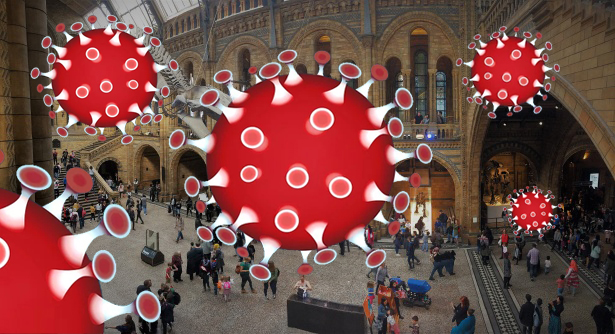
This morning I sat down and ran a simple search across a number of search engines. My search term was, ‘museums and galleries impact of coronavirus’. I restricted my search to the past month only. Here are just some of the results that came back.
New York’s Museums Are Cautiously Preparing for the Coronavirus
Coronavirus impact on China’s art world now eclipses Sars
Coronavirus Fears Shut Down Beloved Bay Area Treasure, the Exploratorium’s Tactile Dome
Museums and galleries closing because of Coronavirus
Museums Shut Indefinitely Over Wuhan Coronavirus
HOW MUSEUMS AND ATTRACTIONS ARE PREPARING AND RESPONDING TO CORONAVIRUS
From Coughing Fits to Closings, Cultural World Girds for Coronavirus
Impact of the Coronavirus Ripples Across Asia: ‘It Has Been Quiet, Like a Cemetery’
It’s clear that COVID-19 is having and will continue for some time, to have adverse impacts on travel and tourism. It is also clear, and no secret, that Galleries and Museums have a heavy reliance on tourism. Tourism means more visitors, more income and most importantly, more engagement. Engagement is THE metric for the GLAM sector. Engagement equals income. I have no doubt that the assault of COVID-19 will abate and eventually go the way of Severe Acute Respiratory Syndrome (Sars) in 2002 to 2003, and Avian Influenza A(H5N1) in 2004 to 2008.
In all cases such outbreaks have a felt economic impact. I personally have no doubt that the future trend is for more such pandemic events. In each case such events will have a measurable impact on our cultural heritage institutions. As travel plans are changed or delayed and wide geographical regions effectively become locked out, we are seeing a rapid decline in visitor numbers. This decline in numbers equates to a decline in income. Most cultural heritage organisations have chosen to close their doors completely . Here are just a few quotes to highlight this point.
At the Whitney Museum of American Art in New York, ‘the maintenance workers have doubled the number of times per day that they clean door knobs, railings and other surfaces.’
The two simple quotes above highlight the issue of additional incurred expense and time without a guaranteed income to offset these expenses and inconveniences. If the threat of pandemic continues into the northern summer, we can expect to continue to see impacts on all cultural heritage institutions. Visitor numbers will continue to drop. The economics of keeping the lights on don’t look good. The recovery time from such events can generally be measured in the years.
So, is it all doom and gloom? Personally I do not think so. I feel events such as COVID-19 will be a part of the future. They seem to come in more regular cycles now. There is an outbreak, we all hunker down, it passes, and we get on with it. However, we are also seeing that with our growing physical interconnections that these events are spreading faster and taking longer to bring under control. We need to adapt to this landscape. Museums and Galleries need to be able to, metaphorically speaking, keep their doors open during these events.
Improving Digital Access
The case for improved digital access and indeed monetizing this access to some degree has never been better. We are now at a technological point where user experience and expectation are paramount. Frameworks like WebGL are offering robust solutions for 3D immersive experiences. We are now able to offer environments which allow users to create their own narratives and shared experiences within the digital walls of the institution. Whilst we will not be moving away from the standard 2D website format any time soon, we are now able to embed these experiences within them. Take the Women’s Wealth and Princess Diana 3D Virtual Museum as example. Both these environments are served up through the traditional (and familiar) 2D web page. Users can step into a 3D world where they can not only experience the environment but also interact with it at varying levels.
Making Exhibitions available Online
By making permanent exhibitions freely available online in a format which allows greater user immersion and flexibility, institutions can keep their doors open at all times. Providing 3D interactive access to a permanent exhibition does not mean that visitors will be kept away from the actual physical space. If anything, it provides an informative ‘first look’ at the institution and builds familiarity. Institutions will be able to reclaim their lost visitors and can go far beyond that and reaching people who do not have the opportunity to visit the gallery in person.
This leads me to my point regarding monetizing aspects of this approach. It is common knowledge that temporary and travelling exhibitions are costly to set up. They generally require some form of paid admission to fund them. This is common practice and does not deter visitation. Why not then do the same in a digital context? Temporary exhibitions can be recreated and made available as a user-pays system. I am not suggesting that the generally high price of admission to a physical exhibition be applied here. Indeed, this is an opportunity to reach a wide audience and therefore can be provided at low cost to the consumer. Additionally, in these trying economic times such solutions may serve to foster engagement whilst generating income for the organisation.
A question will remain as to how effective such strategies and the corresponding investment will be. It is certain that online interactive experiences can and do engage audiences. They build familiarity and trust with the organisational brand. We are seeing the early uptake of these technologies as an alternative to physical visitation.
Virtual Tours and Gamification, China’s Museums Pivot Content for Coronavirus
What is certain given current events is that museums will need to adapt and seek new revenue streams in addition to the traditional methods. Personally, I think it is probably the way to go but we will not know unless we try.

Dr. Lazaros Kastanis
Director
